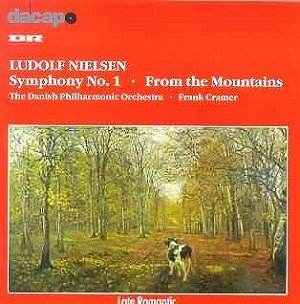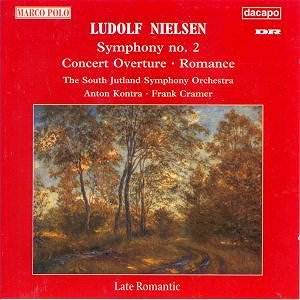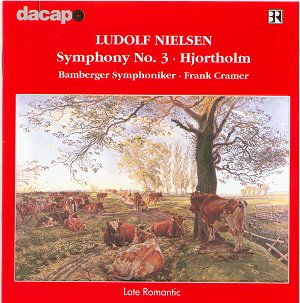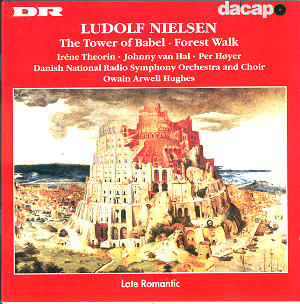Apart from the second symphony all these discs
have been reviewed here before (details below). However seeing
these discs on the shelf it occurred to me that an overview was
in order
The three symphonies are conducted by Frank Cramer
but in each case with a different orchestra. The Tower of Babel
disc stands to one side from the symphony cycle and is conducted
by Owain Arwel Hughes.
Melodic and tonal resource were clearly important
to Ludolf Nielsen who traced his lineage from Grieg, early Carl
Nielsen and a little from Alfvén. The line reaches back,
at its earliest, to Raff and Schumann.
The First Symphony is discursive, rhapsodic,
celebratory but without that last ounce of distinction in the
themes. It bears comparison with Goldmark's Rustic Wedding
symphony and Schumann's First Symphony The Spring.
Nielsen's curvaceous themes bear some resemblance to early Carl
Nielsen in his own First Symphony.
The charmingly pictorial In the Mountains
is a symphonic suite. It is insistently craggy in The
Castle Ruin, gracious like Grieg and playful yet lonely in
The Shepherd. What stands out is the highly skilled orchestration;
the acme of clarity in a romantically-inclined composer like Ludolf
Nielsen. The finale has effervescence à la Karelia
complete with optimistic birdsong and Scandinavian rural high
spirits. All in all this is a highly entertaining and poetically
imaginative suite.
The Danish Philharmonic is not a luxury instrument.
Certainly the sound of the massed strings as rendered here is
not a thing of beauty although the spirit of the work appears
to come across well.
The Concert Overture belongs to the jaunty
lighter woodland romance tradition of Fibich's A Night at Karlstein
and Korngold's music for The Adventures of Robin Hood a
tradition traceable back to Weber's mythic forest glades.
Speaking of lineage we need look no further than
Saint-Saëns for the sweet fluency of the Romance for
violin and orchestra. There is also more than a touch or two of
Bruch about this writing. Melodically speaking this is a much
more distinctive piece than the violin romances by Peterson-Berger
and Stenhammar. It is most sweetly despatched by Anton Kontra.
The Second Symphony while seeming at first
to be made of more concentrated fibre than the First soon reverts
to jolly type. Here we have more of the chivalric pomp of some
sylvan court - a genial magic that links with the writing of J.P.E.
Hartmann and Gade. And so the theme continues through the four
movements sometimes also relate to Mendelssohn and at one time
and at others with woodland Bruckner. It is never short of restless
elegant invention. The finale (lento into allegro vivace)
skitters and flits in Midsummer Nights' Dream delight -
sunny and warming music.
The Second Symphony has competition in the shape
of the excellent Ole Schmidt's recording on CPO which has a more
polished orchestra than Cramer.
The Third Symphony looks in one direction
towards the Bruckner of the Fourth and Seventh Symphonies and
at the others towards the discursive Danish tradition represented
by Louis Glass’s Third and Fifth Symphonies. It has especially
by comparison with its two predecessors a grand romantic sweep.
Nielsen returns to type at times with music of village celebration
characteristic of the first two symphonies and the earlier orchestral
suites. He also accomplishes music of wafer-like fragility approaching
the romantic-expressionism of Zemlinsky’s Seejungfrau.
The Symphony closes with a fine and noble theme that passingly
reminds the listener of vintage Jerry Goldsmith!
Hjørtholm is the latest
piece included on these four CDs. In Lyngby to the North of Copenhagen
there had been a castle of this name standing on the shores of
Lake Furesø. The castle stood for 300 years but was destroyed
as were so many Catholic strongholds during the civil war of 1536-36.
Although not a trace of the castle stood during Nielsen’s day.
The piece is stark and tragic, inclined to darkness, rife with
horn-calls. The tragedy is occasionally in brief remission for
moments when the composer looks back on the festivities with which
the great hall must have rung. Predominantly however this is a
gloomy and powerful work. Its sense of place, fantasy and time-travel
can be compared with John Ireland in Mai-Dun and The
Forgotten Rite.
Frank Cramer who pilots the three symphonies
and their suites and tone poems was born in Essen in 1954. Würzburg
was his first musical directorship. He came under Horst Stein's
influence in Hamburg as a budding conductor. He shows the same
fastidious care as Stein to balance the contours of orchestral
sound and is as responsive as Stein to changes in tempi and dynamics.
Stein's few recordings include a 'Hall of Fame' Sibelius tone
poem collection (Decca Weekend, Suisse Romande) are exemplars
of spontaneity and the conductor's art. His En Saga and
Pohjola's Daughter should be in the collection of any true
Sibelian.
And so we come to the last and I think most impressive
disc and a change of conductor. He is well known in Denmark and
Sweden, the always imaginative and adventurous Owain Arwel Hughes.
Having recorded all three of the symphonies Da Capo might have
been tempted to take a long sabbatical. Not a bit of it. Instead
they tackle the massy heights of Nielsen's setting of a poem by
Gyrithe Lemche in whose home Nielsen stayed during country holidays.
It was during such a holiday that the inspiration for Hjørtholm
came to him. The Lemche poem Tower of Babel extols
the perfection to be achieved through spiritual exaltation. The
setting runs to 35 minutes and is for substantial forces including
three soloists and a semi-chorus of four other voices alongside
a very full choir all with grand orchestra.
While the First Symphony threshes about under
the shadows of Schumann and Goldmark this work is far more distinctive
and imposing. Baritone, Per Høyer is in darkly stern and
secure voice - another Jörma Hynninen if ever I heard one.
Tower of Babel has the flaming conviction and some of the
sound-world of Rudolph Tobias's Jonah's Mission (on Bis
and not to be missed), of Verdi's Requiem and of Havergal
Brian's Siegeslied Symphony (on Marco Polo). With Rued
Langgaard and Louis Glass, Nielsen had idealistic Millenarian
visions as also, some years later, had John Ireland in These
Things Shall Be. It is intriguing to hear this work alongside
Langgaard's Music of the Spheres and Sinfonia Interna
(also on Da Capo). When you come to the beginning of Part
2 of The Tower one can hear the clearest kinship with Langgaard
woven with much the same line and light as Lange-Müller and
Gade. You may also be put in mind of the outdoor songs and pastoral
idylls of Ludolf’s namesake’s Springtime on Fyn (superbly
done by Mögens Woldike on Regis). In the peroration the music
develops a confident bell-swing. Extremely enjoyable!
From the second part of Babel it is an
easy footstep to Forest Walk which is, at first,
quite Straussian (the Danes have often been under the sway of
influences from their southern neighbours). Pan's pipe (flute-articulated)
wreathes these pages in secret smiles amid rustling undergrowth.
The birdcalls and general Swinburnian ambience will be familiar
to admirer's of Bax's unnumbered Symphony Spring Fire and
more familiarly to anyone who knows Ravel's Daphnis and Chloe.
‘Pan by noon and Bacchus by night’, indeed. The other parallel
is the central movement of Carl Nielsen's Sinfonia Espansiva.
In the concluding section Towards Daybreak the music tilts
towards the harmonic complexes of Schoenberg's Verklärte
Nacht and Josef Suk's Wenceslas Meditation. This is
a most surprising discovery and well worth your investment. The
performances are utterly convincing.
The discs' many strengths are buttressed by Jens
Cornelius's liner notes which uniquely satisfy the curiosity that
this music is bound to engender. In the case of the Babel
disc full texts and translations are given.
From the discursive symphonic suite style of
the First Symphony to the earnest Brucknerian Third. From the
gambolling Concert Overture to the stygian intensity of
Hjørtholm. If you must have only one of these then
try the strongest music which is without doubt the visionary The
Tower of Babel and Swinburnian Forest Walk.
Rob Barnett
other reviews
Symphony
1 Rob Barnett
Symphony
3 John Phillips
Tower of Babel John
Phillips Rob
Barnett
see also Quartets
2&3

![]() Danish PO/Frank Cramer
Danish PO/Frank Cramer
![]() DACAPO 8.224093 [71.25]
DACAPO 8.224093 [71.25]

![]() Anton Kontra (violin)
Anton Kontra (violin) ![]() DACAPO 8.224047 [59.33]
DACAPO 8.224047 [59.33]

![]() Bamberg SO/Frank Cramer
Bamberg SO/Frank Cramer
![]() DACAPO 8.224098 [67.20]
DACAPO 8.224098 [67.20]

![]() Danish National Radio SO
and Choir/Owain Arwel Hughes
Danish National Radio SO
and Choir/Owain Arwel Hughes ![]() DACAPO 8.224157 [63.05]
DACAPO 8.224157 [63.05]